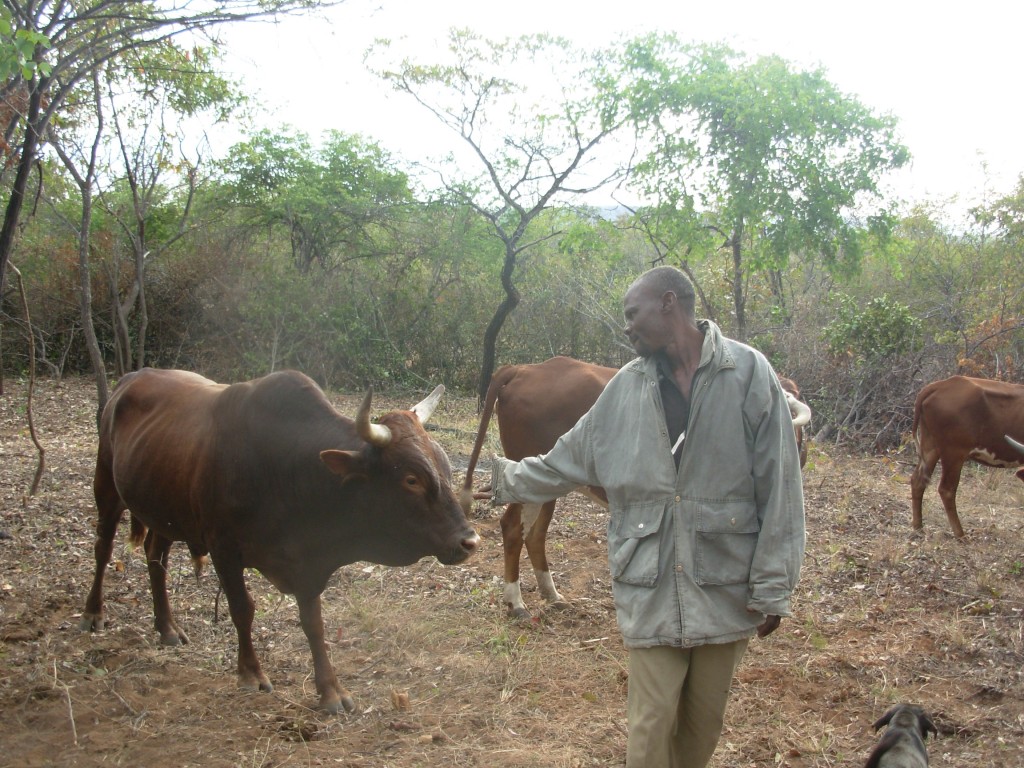Communal farmers set to restore Zimbabwe’s bread basket status
Jan 21, 2015
Story

Hwange: Communal farmers in Chidobe ward in Hwange district of Matabeleland North province are realizing bumper harvests after introducing a technique of using their livestock to treat cropfields before the planting season.
Treating cropfields using livestock ensures that the soil is healthy.
A healthy soil is a complex community of life. It supports the most bio-diverse ecosystem on the planet.
Livestock play a critical role in maintaining healthy soils. When bunched together into a tight herd, livestock use their hooves to break the soil crust to allow soil to absorb more water. They compact soil and this encourages better seed-to-soil contact resulting in better seed germination. Livestock also achieve litter cover by returning standing grass plant cover material to the soil surface through trampling and they improve soil quality with dung and urine.
The initiative is the brainchild of a local non-governmental organization, the Africa Centre for Holistic Management.
A Programme Manager for the Africa Centre for Holistic Management (ACHM) who is working under chief Mvutu area, Ms. Mupenyu Ndiani Gumbo-Mberi, says the community has realized the importance of animal treating the cropfields.
“One of the farmers involved in the treating of cropfields is Mr. Marko from Chidobe community under chief Mvuthu’s area. Mr. Marko has been doing this activity for the past two years now. Last year he animal treated his crop fields using 60 cattle from his own herd and he realized a significant increase in yields,” says Ms. Gumbo-Mberi. Ms Gumbo-Mberi added that Mr. Marko used 40 cattle this year to animal impact his crop field and that he sometimes loans his cattle to other communal farmers in the area so that they can also treat their cropfields.
Ms. Gumbo-Mberi says that Mr. Marko learnt about animal impacting from Irene Mpala from Sizinda community who had animal treated her cropfield and produced high yields using only seven goats.
“Irene Mpala is one of the few community members who started to animal impact their crop field when the knowledge was introduced to the community. Before the knowledge of animal treating cropfields was introduced to communities, farmers would have the extra labour of carrying dung from the kraals to the fields,” said Ms. Gumbo-Mberi.
Ms. Gumbo-Mberi said Irene Mpala has been animal treating her cropfield for the past three years and this is her fourth year.
Farmers who animal treated their cropfields harvested more crops during the 2010-2011 farming season. Animal treating a cropfield is putting livestock overnight in a corral [kraal] that is temporarily established on a section of the cropfields and shifted after approximately seven days. During this period, livestock urinate and this provides the nitrogen for healthy plants. The dung provides the living organisms and organic matter to hold the water in the soil when the rain falls. The hooves of the animals till the soil so that air and water enters.
This innovative method is proving to be popular in the 10 communities in Hwange where we are implementing a Land and Livestock Management programme aimed at restoring land to health while successfully addressing climate change and enhancing livelihoods.
Animal treated cropfields in Monde, Sizinda, Dibutibu and Mabale communities had higher yields than control crop fields. For instance, maize harvested in an animal treated cropfield in Monde was 2 tonnes per hectare while the field which was not animal treated produced 0.1 tonnes per hectare.
In Mabale, the animal treated cropfield yielded 5.5 tonnes per hectare while the control filed produced 0.4 tonnes per hectare. In Sizinda, the animal treated cropfield produced 4.4 tonnes per hectare while the control field harvested 1.8 tonnes per hectare and in Dibutibu, the animal treated cropfiled reaped 2.6 tonnes per hectare while th field which was not animal treated had 6.8 tonnes per hectare.
The knowledge of animal treating the cropfields was introduced to the community by Africa Centre for Holistic Management, a local non-governmental organization based in Hwange.
Africa Centre for Holistic Management is currently working with 10 communities in Hwange. These communities comprise of approximately 245,000 people and they are represented by five chiefs who seat on ACHM’s Board of Trustees.
Communities in Hwange have realized the significance of animal treating the cropfields and are working as communities rather than as individual families in implementing the project.
In Chisuma and Dibitibu we have groups of people who are working together to animal impact their cropfields. They are putting their livestock together and taking turns to treat their cropfields. In some cases groups treat one member field during the farming season or they decide to treat a portion of each member’s cropfield during each farming seasons.
Besides improving crop yields, the project has brought unity of purpose as people are coming together; bringing their livestock together for one purpose, that is ensuring that they improve their livelihoods, restore degraded land and natural water sources to health.
Our role is to act as facilitators while communities work together towards a common goal – what we refer to as the Holisticgoal. The Holisticgoal looks at the quality of life a community wants. It identifies what needs to be in place, what needs to be produced to attain this desired life and it clearly maps the future a community would like to have.
This initiative has changed the fortunes of communal farmers like Marko who were relying on expensive artificial fertilizers. As more communities adopt this strategy, there are high hopes that Zimbabwe can get back to its bread basket status in Africa.




